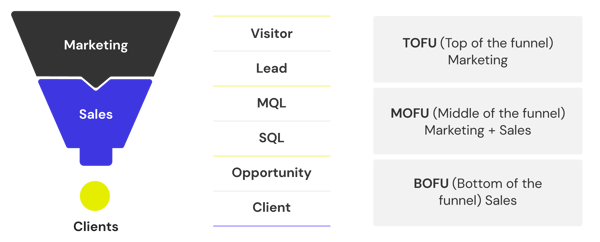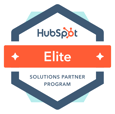INBOUND MARKETING: What is it?
Concepts and methodology
We help companies that are willing to invest in long-term digital strategies to generate sustainable business results through inbound marketing, sales, and service methodologies because it is the most intelligent way to grow.

Chapter 1
What is Inbound Marketing?
Inbound Marketing is a methodology commonly used in digital marketing, which aims to attract customers by putting them at the center of your strategy.
In other words, Inbound Marketing focuses on talking to people about their interests and pain points instead of talking about your products or services, or what you want to communicate as a brand.
An Inbound Marketing strategy is fundamentally non-intrusive: it aims to attract users through valuable content that educates and solves your audience’s pain points throughout their research process or “the buyer’s journey.”
A well-executed inbound marketing strategy is 10 times more effective at converting leads than an outbound strategy.
By integrating different digital marketing tactics, you can build a model capable of attracting leads, allowing you to increase your conversion rate and sales, and finally make users fall in love with your business.
- Learn in-depth about what inbound marketing is
-
Learn about the methodology that revolutionized the way of doing business.
-
Discover the features and benefits of inbound marketing
-
Identify the advantages of inbound marketing for companies
-
Understand the differences between inbound marketing and digital marketing
.webp)
Chapter 2
Inbound and Outbound Marketing: What are the main differences?
In the digital world, it’s common for people, companies, and even marketing agencies to confuse concepts.
Sometimes, when a term such as Inbound Marketing becomes highly popular, it starts getting misused.
For example, if you’re currently using digital marketing tactics such as Search Engine Optimization (SEO), email marketing, paid advertising or content marketing, this doesn’t necessarily mean you’re doing Inbound Marketing.
However, a couple of years ago, many digital marketing agencies began to call and offer “Inbound Marketing” as part of their online marketing services, unaware of the fact that Inbound is actually a methodology, or a philosophy, that integrates these tactics.
Something similar happens with the terms “Inbound” and “Outbound.”
Traditional Marketing chases prospects and clients.
Disrupt, chase, and attack.
Strategies are product-centric.
Inbound Marketing focuses on attraction.
AAttract, interact, and delight users.
Strategies are customer-centric.
Leads from an Inbound Marketing strategy cost an average of 61% less than leads obtained by Outbound strategies.
However, executing digital marketing tactics can also be Outbound Marketing if these strategies are isolated, one-directional, and interrupt users.
Inbound marketing is a methodology that is based on the inbound philosophy, a way of doing business that puts the user at the center of the strategy and uses tactics to attract, interact, and delight in order to increase sales, provide a satisfactory digital experience, and create strong relationships with customers.
Outbound marketing, on the other hand, refers to traditional marketing characterized by its focus on the product and the use of aggressive tactics to get the user's attention: a way of doing business that was successful for a long time but is now obsolete, unless it is addressed as a complement to a digital strategy.
Delve the difference between inbound and outbound
-
Definition of inbound and outbound businesses.
-
Main differences and characteristics
-
Difference of inbound marketing with other techniques and methodologies

Chapter 3
How to plan a successful Inbound Marketing Strategy for each phase of the buyer journey
This is how the magic happens: an Inbound Marketing strategy aims to turn a stranger into a business promoter in four steps, using different tactics for each of the different phases.
This journey is commonly known as “The Buyer’s Journey,” which consists of three main stages: awareness or discovery, consideration, and decision.
Awarenes Prospect is aware of a problem. My head hurts and I have a sore throat. What’s wrong with me?
|
Consideration Prospect has found a solution to the problem. I have an infection. What are my options for getting rid of the symptoms?
|
Decision Prospect has decided on their solution, method or approach. I can see my physician or go to the ER. The ER is a bit more expensive but my insurance covers me |
For each of these stages, the Inbound Marketing methodology envisages stages with specific tactics that allow users to seamlessly move from one to the next, while educating themselves.

Fascinating, right?
VENTURE HARBOR
79% of top-performing companies have used marketing automation for three years or more
Delve into the key elements for developing a successful inbound marketing strategy:
-
The buyer persona or representation of the ideal customer
-
The buyer journey
-
The stages of inbound marketing
-
Content as a fundamental piece of an inbound strategy
-
Marketing automation

Chapter 4
The Traditional Sales Funnel
In the world of digital marketing, there is a well-known and powerful tool for attracting visitors and turning them into customers: the traditional sales funnel.
The funnel has allowed us to guide users through the different stages of their “buyer journey,” delivering content to attract users, capture their attention as visitors, then turn them into prospects or leads, and finally into customers.
The funnel used to look like this:

Evolution of the Sales Funnel: The Flywheel
This wonderful marketing tool, however, underwent a transformation process. In other words, it still works, but it’s not as effective as it used to be.
At Triario, we saw first hand how the Flywheel worked during INBOUND18 in Boston, the largest Inbound Marketing event in the world. Since then, we have incorporated this methodology into our strategies and processes.
“Jeff Bezos knew it: at Amazon, the word funnel is never mentioned. Growth is best represented by the Flywheel metaphor, a wheel that feeds itself.”
Brian Halligan
Learn in-depth about what inbound marketing is
-
Learn about the methodology that revolutionized the way of doing business.
-
Discover the features and benefits of inbound marketing
-
Identify the advantages of inbound marketing for companies
-
Understand the differences between inbound marketing and digital marketing
Chapter 5
Inbound Marketing Resources
Download our guides and educational resources on Inbound Marketing for free and start implementing the Inbound methodology now.
Marketing de contenidos desde otra mirada: ventas y servicios.
Murió el embudo de conversión. ¿Cómo pensar en el marketing y las ventas sin él?


